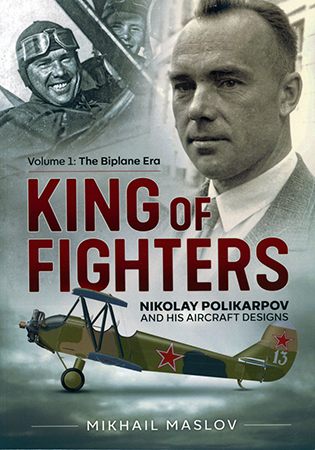
King of Fighters: Nikolay Polikarpov and His Aircraft Designs Book Review
By David L. Veres
| Date of Review | January 2021 | Title | King of Fighters: Nikolay Polikarpov and His Aircraft Designs |
|---|---|---|---|
| Author | Mikhail Maslov | Publisher | Helion |
| Published | 2020 | ISBN | 9781911628859 |
| Format | 278 pages, softbound | MSRP (USD) | $39.95 |
Review
Historian Mikhail Maslov expertly explores the work of a legendary Soviet aviation pioneer in King of Fighters: Nikolay Polikarpov and His Aircraft Designs (Volume 1 - The Biplane Era) – available in North America from Casemate.
Hundreds of photos and dozens of scale drawings support the study. And dozens more color profiles survey the swath of Polikarpov biplane liveries.
Coverage literally brims with fascinating facts.
Did the hopelessly obsolete I-5 biplane fighter actually see combat during WWII? And did Po-2 pilots routinely cut engines to approach enemy targets in total silence during night attacks – as popular lore claims? Maslov reveals what really happened.
Nor must you sequentially traverse this terrific tome.
After opening remarks, I visited the I-5 and I-153, segued to the I-15, I-15bis, and R-5, lingered at the U-2/Po-2, then rambled through the rest.
Chapters on the Po-2, I-153, and R-5 proved particularly riveting. Discover, for instance, how Po-2 crew cleverly employed flare guns in combat. And learn how prolific all-female units really were.
Still, gremlins stalk this otherwise splendid study.
Translation and diction, for instance, appear awkward. Punctuation and layout errors in body quotes also confound clarity. And the lack of annotations proves perturbing in a work of this size and scope.
Perhaps more substantively, why include a chapter on early fighter monoplanes among the book’s titular biplane subjects?
And why essentially ignore a key R-5 derivative – the R-Z? Maslov himself calls it “a new R-5 version” in his Polikarpov R-5 & R-Z (Paris: Editions TMA, 2002, p.54). So why not here?
Still, carps aside, I loved this book. With the sheer volume of Maslov’s illuminating information and insights, I eagerly await his sequel on Polikarpov monoplanes.
Robustly recommended!
With thanks to Casemate Publishing for the review copy!







